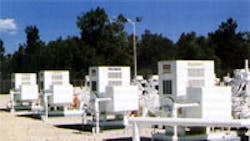Tutorial: Selecting an appropriate pump motor
The countertorque from a centrifugal pump is the typical parabolic curve with torque varying as the square of speed. Inertia (WK2) of most pumps is low; so low, in most cases, that it does not affect motor design. Typically, pump inertia is no more than 10% of the standard load WK2 as defined in National Electrical Manufacturers Association specifications.
Because induction motors have reasonably high starting and breakdown torques, pump applications become difficult only in reduced or low-voltage starting conditions. Synchronous motors accelerate in the same way as induction motors, using their damper bar cages to produce torque. Hence, you should investigate low-voltage starting of synchronous motors in the same way you would for induction motors. Typically, when designing a motor to accelerate a large pump, consulting engineers make the voltage-drop calculations, and the results are forwarded to the motor manufacturer.
In most situations, you can reduce the pump load on the motor by closing the pump discharge valve. This method of load torque reduction is almost always needed for acceleration with a low-voltage requirement.
You should get a load-speed torque curve from the pump manufacturer, showing both the open-valve and closed-valve speed-torque curves. Figure 1 is an example of such curves, with motor torque curves superimposed. As the voltage is reduced at the motor terminals for starting, the motor torques are reduced at a differential slightly greater than that given by the square of percent voltage.
For example, a motor with 80% rated voltage at the terminals could produce output torques near 64% of full-voltage torques. The true value is slightly less than the square of voltage, depending on motor design. Figure 1 shows this effect.
In most cases, closed-valve starting is the only means available to let the motor accelerate the pump at reduced-voltage conditions. The pump valve remains closed only for the time it takes to accelerate the motor and pump. Then the valve is opened and the pump draws its full load from the motor. The pump cannot operate with a closed valve for long periods without risk of damage from excessive heat. Closing a valve for acceleration usually results in pump load torques in the area of 50 to 60% of full-load torque at full speed.
The uppermost curve in Figure 1 is the motor full-voltage output torque. The second curve from the top shows the effect of voltage reduction. The bottom curve is the pump speed-torque curve with a closed valve until the pump accelerates fully. At that time the valve is opened and the pump requires its full-load torque from the motor.
The “open valve” curve shows how the pump load would look if the valve were not closed for acceleration. This design motor would not accelerate at reduced voltage — the open-valve pump curve crosses above the reduced-voltage motor curve. In that zone, the pump demands more torque than the motor can supply at reduced voltage.
Mixed-flow pump drive
The impeller of a mixed-flow design pump imparts both axial and radial movement to the pumped fluid. For this type of pump with the discharge valve open, the load as seen by the motor is much the same as it would be for a centrifugal pump. However, closing the discharge valve on a mixed-flow pump does not have the significant torque reduction that goes with a centrifugal pump.
Typically, values of 80% of full-load torque at full-load speed could be expected, Figure 2. However, there is considerable variance with closed-valve torque requirements for mixed-flow pumps. Hence, to get the right motor design to accelerate the pump load, it is almost essential to get the true pump speed-torque curve.
Axial-flow pump drive
The impeller (that is, the propeller) of an axial-flow design pump imparts flow parallel to the shaft. With this type of pump, closed discharge-valve torque requirements are greater than if the pump were started with the valve open. If there is a requirement to start the axial-flow pump with the discharge valve closed, you need the pump speed-torque curve.
Figure 3 shows an application where the required torque at full load is 150% of motor full-load torque in a closed-discharge situation. It is not unusual for the value to be significantly higher than that represented in Figure 3.
For you to have the proper analysis for any type of pump, you must give the motor manufacturer the values for voltage drop and pump inertia, and the pump speed-torque curves for open and closedvalve conditions.
Richard F. Halfpap is Marketing Manager — Large Motors and Generators, MagneTek, Milwaukee.
